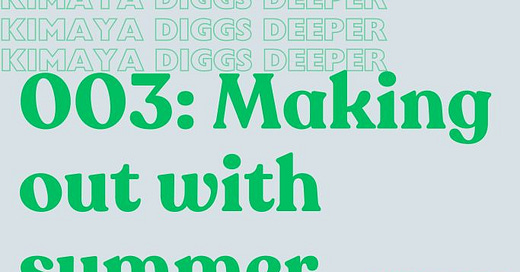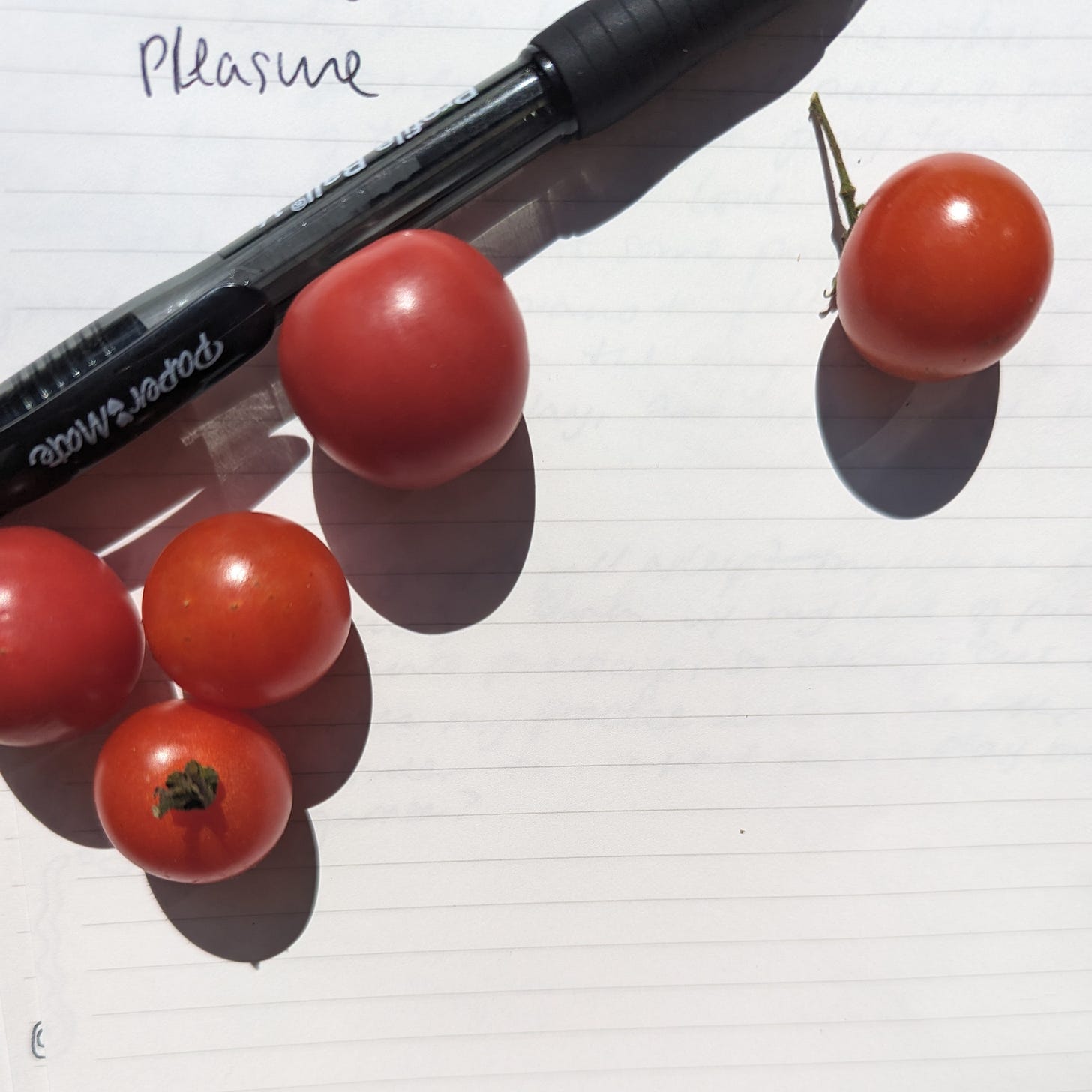Kimaya Diggs Deeper 003: Making out with summer
Unpacking my tomato obsession, and it turns out maybe I'm in love with the earth????
Song of the day
The song of the day is Crave You by Flight Facilities and Giselle!
Making out with summer
If you follow me on Instagram, you might have noticed that I’ve been eating a lot of tomatoes. A LOT of tomatoes. Like tomatoes on toast for breakfast, tomato/mayo sammies for lunch, pesto pasta for dinner, topped with…yes, you get it.
I’m lucky enough to live in the Pioneer Valley in Massachusetts, where heirloom tomatoes grow in rich abundance during the latter half of summer. But this year’s love affair with tomatoes has superseded every summer before, and I’ve been wondering why.
(My best friend had a theory which I’ll share later in the post…,)
I don’t have a lot of money. I’m not a ~foodie.~ But for me, eating fresh heirloom tomatoes is the truest form of food luxury. A tomato is a little world of its own, with surprising stripes, color, and sweetness and acidity streaked through the flesh. It’s a thing of beauty.
(Unless it somehow manages to sprout internally, which is – I’m warning you – very disgusting looking. But hey, that’s just more of a metaphor for life. Or something like that. Idk I’m not spelling it out for you! Take whatever meaning from it you please!)

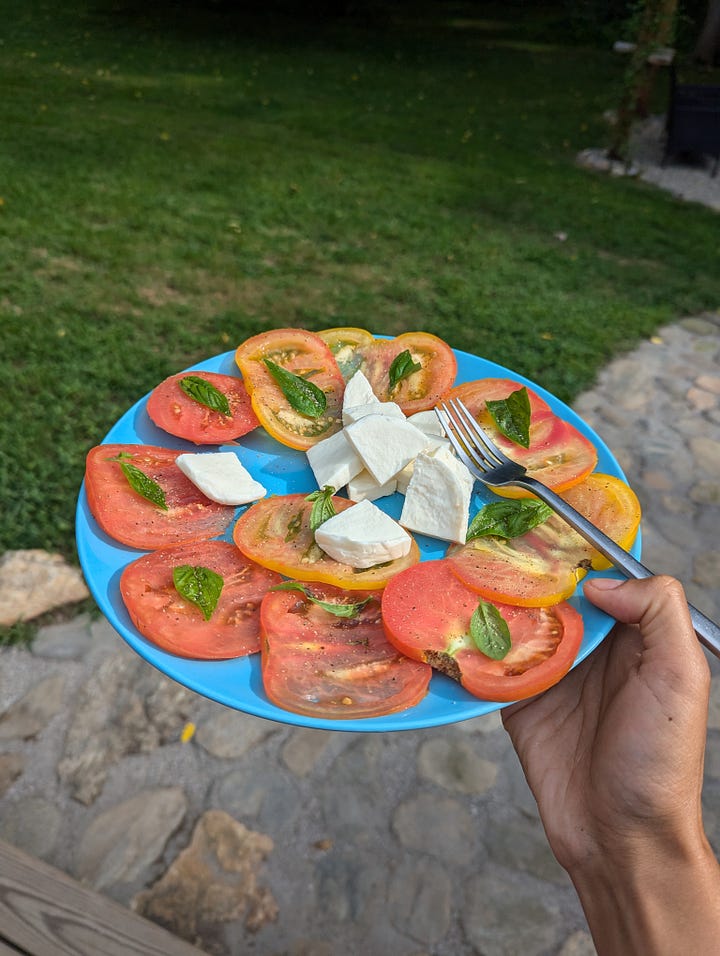
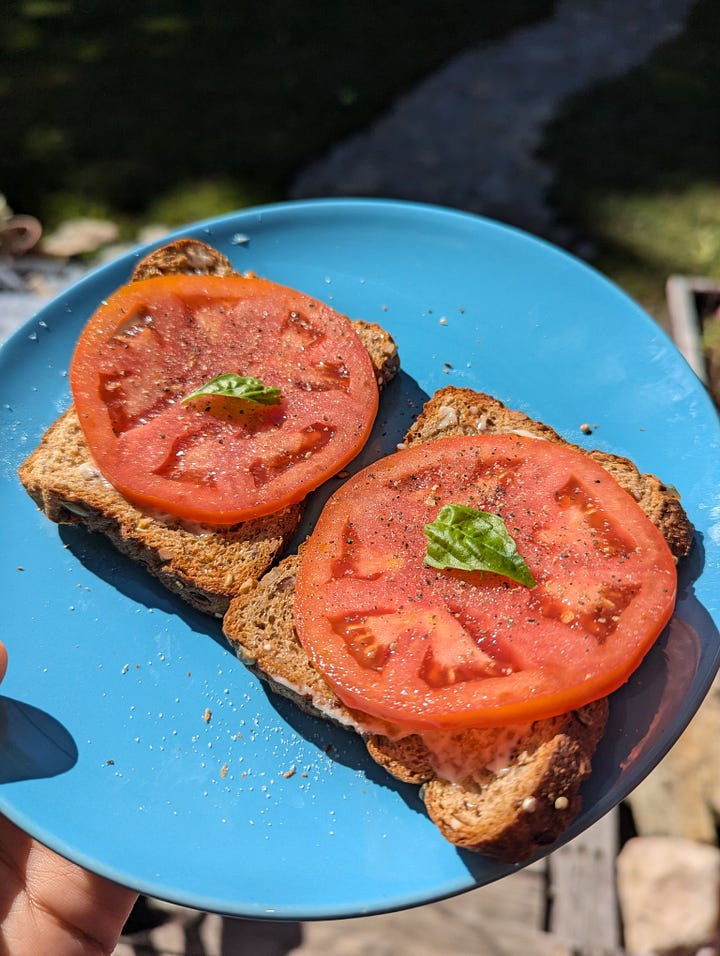
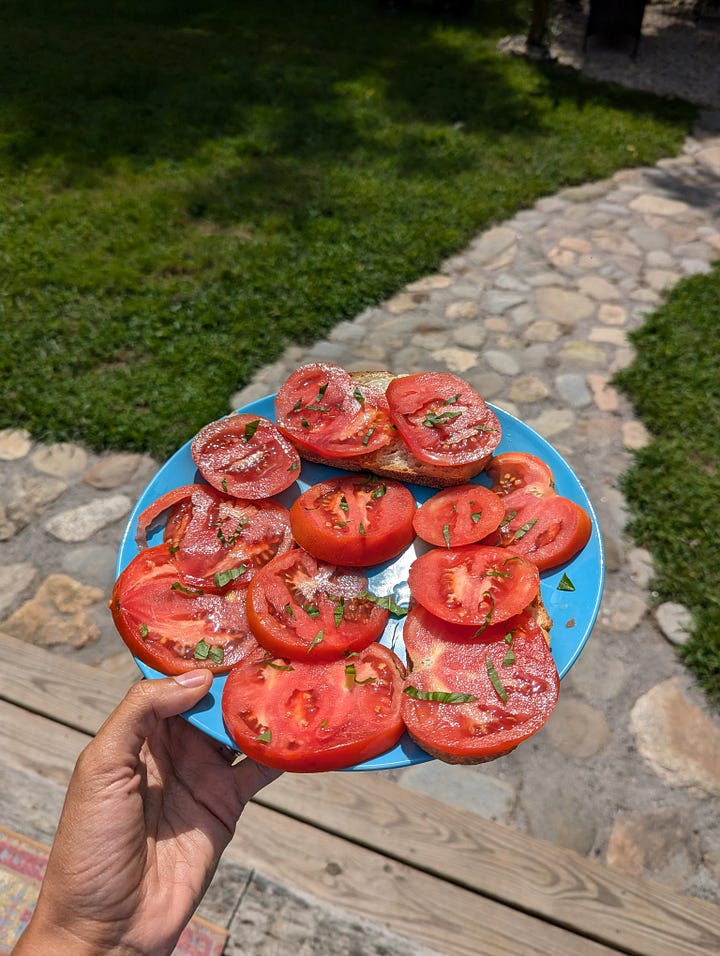
Part of it is that I’m eating at all.
I live with chronic pain, an autoimmune illness, and depression, and because of my health challenges, I’ve always struggled to stay on top of my food intake. I’ve subsisted on cheese sticks and peanut butter pretzels and Ensure for many summers before this. (More on being creative while chronically ill next week)
Part of it is that I’ve stopped moving.
I’ve lived in the same town for four years now. Prior to that, I moved a lot, and when you don’t settle, it’s easy to miss the cycles of nature that are at play all around us.
Part of it is that the cycle has a gravitational pull.
The cycles of the year — the changing seasons and the plants and animals that accompany each shift — have felt louder to me ever since I moved to my town and decided to make it my long-term home. It started with an unexpected delight: invasive Japanese knotweed. (Side note: invasive plants are bad. This was just my entry into loving the cycles of nature.)
My first apartment in my town had a backyard full of knotweed. When I moved in, it was a gloomy pile of pale, grey-brown stalks that rustled in the autumn wind. Through them, I could see into the back of the house on the other side of the block – even without intending to spy. Through the winter, I saw them cooking, reading, and doing homework. My own bedroom window likely glowed back at them, so I kept the curtain drawn.
Suddenly, in late spring, the ground behind the apartment went wildly green, and the knotweed awoke. It grew fast – six inches a day, it seemed – until it formed a thick quiet barricade of broad green leaves. Small creatures moved in at the base of the stems and squeaked, buzzed, and croaked through the twilight. My neighbors were invisible in the dark, except for a small spark of light visible through the wall of knotweed. I left my bedroom windows open, curtain pulled to the side.
Next spring, I awaited that growth with excitement. It was such a transformation, and so fast. It was thrilling, and fun to change my behavior (bedroom curtain) based on what plants were doings.
When I moved to my current place, I felt the same. I looked out into the vast yard – the lawn and the wooded area – and took in the invasive vines, the plants that grow irritating burs and the plants you can eat. The poison ivy. The Virginia creeper. The maples and the black walnuts and the jewelweed.
I learned to know, and therefore love my yard. Did you know that jewelweed can prevent a poison ivy rash? That you can steam and eat early spring poke shoots before they turn poisonous? That you can sprinkle purple and yellow violets on salad, or steam the dark green leaves like spinach? That you can lay on your belly in the grass and chew on lemon clover and purslane? Did you know that if you gently bite a leaf of purslane with your front teeth you can hear a tiny, styrofoam-like crunchcrunchcrunch? That fireweed grows where we dump our fire pit ashes, and hairy beardtongue opens its flowery ‘mouth’ when certain species of bees land on them?
To know my environment is to love it, and to be a part of it forever.
It makes me eager for the fall and winter and spring and summer and fall and winter and spring and summer and fall and winter and spring forever and ever until my skin and bones and guts become even more a part of it all when my life is over.
Back to the tomatoes.
Living somewhere for four years doesn’t automatically make you a part of the environment. In fact, it’s much easier to avoid becoming a part of your environment because it takes work, time, patience, and an acceptance of whatever the earth throws your way (in my case…SO MANY FUCKING BURS). It’s easier to put a fence around it and move on. It’s easier to go to the grocery store and buy a Californian tomato, whether in January or July.
But you do lose something. If you want tomatoes in the winter, you’re going to have to sacrifice taste, and texture, and genetic variation, and color, and connection to the land where you live. It’s why we invented things like sun-drying tomatoes or cooking them into sauce. For hundreds of years, nonnas in kitchens have known that a fresh tomato will never give you what you want in the off-season, like a relationship or a lover won’t give you what you want after it’s past its prime.
You’ve planted seeds, nurtured it, pruned and staked it where you need to, eaten the incredible fruit, let the juice get all over the dang place, and now it’s gotta wither and go back to the earth. Maybe for good. Or maybe it’s a perennial and it’ll be back next year, stronger.
Making out with summer?????? wait srsly?? ٩(◕‿◕)۶ i mean she’s so pretty but like afl;jkda;fkdja omg i’m literally blushing rn do u think she likes me back?? (⁄ ⁄•⁄ω⁄•⁄ ⁄)
My last thought is one I’ve been turning around for a bit: I like to joke about ‘making out with summer’ when eating a tomato / peach / cantaloupe / other local juicy veg and I started ruminate… I mean, I have a degree in English and have spent many an hour in poetry workshops talking about how peach juice dripping down one’s chin speaks to the innate eroticism of blah blah blah
Here was my best friend’s take:
“When you said ‘eating an heirloom tomato’ I thought it’s gonna be about fucking.
I mean, she’s not wrong?? So let me try something out – maybe the cycles I keep talking about aren’t just the seasons going around. Maybe it’s more like a birth-sex-death cycle wherein we (every living creature on earth) are born, consummate our adoration or lust or biological imperative, then wither and die, returning to the earth as bones or feathers or seeds. And like I said before, maybe our lives and relationships are annuals, destined to be a one-time-only memory, or maybe they’re perennials, growing deeper roots even as winter approaches.
If you think I’m asking is eating a tomato the same as having sex? The answer would be: kind of, yes.
Making out with summer is engaging with the land and the environment. It’s surrendering to what the earth has to offer and seeking pleasure in the tiniest intimacies — like the bees that only I can hear from where I’m sitting, or the tomato that fed me. It can be joyous and tender and harsh and challenging. It’s an expression of love and want. It’s a celebration of receiving a truly singular gift from the earth: a fruit made for anyone who wants it, needs it, can enjoy it.
Making out with summer for creativity
Can you tell that I like extended metaphors? Let’s bring this eating-a-tomato-is-intimacy home to creativity. I stretched this morning, so I’m ready to make the leap.
The life cycle of the tomato is the same as the life cycle of a creative project is the same as the life cycle of any creature with a life. The seeds, the shoots, the stakes that provide a structured container for your work and safeguard it against falling apart as it gets bigger and more real.
Pruning is…you’ve got this. I don’t wanna hit you over the head with the metaphor too hard.
Then you get to THE TOMATO!!!!!!! A BRIEF, very shining window of time in which all your work comes to literal fruition. You have to eat it. You have to make all your friends try it. You have to consume it raw and fresh. If you try to capture it in time, it will rot and you’ll have to clean up nasty moldy tomato scum. Eat it now. Tell everyone you had it and you loved it. Recommend it to people. Obsess over it. Take a thousand photos. Eat it fast. Eat it slowly. Let it consume your thoughts until you go crazy.
Then the vines wither and the ground gets tilled for the next season.
Creativity is difficult for me sometimes because I work SO. HARD. for months, if not years, behind the scenes, honing my skills, writing, editing, world-building, planning, emailing, and then when a new song comes out, it’s the first anyone’s ever heard of it. The growing part can feel lonely, even more so in hindsight if you don’t celebrate your creations with the fanaticism of a lover.
Sharing creative work represents the end of something to the creator, but the beginning of something to the audience. That can be hard to take. Unless you take it with all the curiosity and open-mouthed pleasure-seeking-ness of biting into an heirloom tomato at the peak of the season.
Nothing lasts. Enjoy it.


